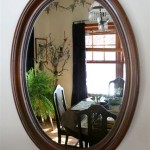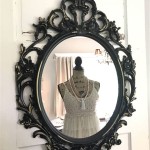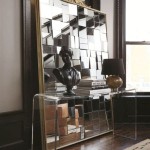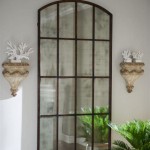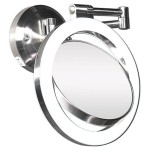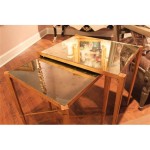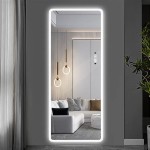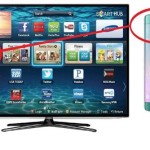Tempered Glass Mirrors: Strength, Safety, and Applications
Mirrors are ubiquitous in modern life, serving functional and aesthetic purposes in homes, businesses, and public spaces. While traditional mirrors are typically made from annealed glass, tempered glass mirrors offer enhanced durability and safety features, making them a preferred choice for various applications. This article will delve into the characteristics, manufacturing process, advantages, and diverse uses of tempered glass mirrors.
Tempered glass, also known as toughened glass, undergoes a specialized heat treatment process to significantly increase its strength compared to annealed glass. This process involves heating the glass to a high temperature, close to its softening point, followed by rapid cooling. This rapid cooling creates a compressive stress layer on the surface of the glass, while the interior remains in tension. This stress balance is what gives tempered glass its increased resistance to impact and thermal stress.
The key distinction between annealed glass and tempered glass lies in their behavior upon breakage. Annealed glass, when broken, typically shatters into large, sharp shards, posing a significant safety hazard. In contrast, tempered glass, when broken, shatters into small, relatively harmless fragments. This fragmentation pattern is a direct result of the internal stress distribution within the tempered glass and dramatically reduces the risk of serious injury.
Tempered glass mirrors are produced by applying a reflective coating to one side of the tempered glass sheet. This coating, typically a silver or aluminum amalgam, is then protected by one or more layers of paint. The resulting product combines the reflective properties of a mirror with the enhanced strength and safety characteristics of tempered glass.
Advantages of Tempered Glass Mirrors
Tempered glass mirrors offer a multitude of advantages over traditional annealed glass mirrors, making them a superior choice in numerous applications. These advantages stem primarily from the inherent properties of tempered glass itself.
Increased Strength and Durability: The tempering process significantly increases the mechanical strength of the glass. Tempered glass can withstand considerably higher impact forces and pressure compared to annealed glass. This increased strength makes tempered glass mirrors less susceptible to breakage from accidental bumps, knocks, or minor impacts. This enhanced durability translates to a longer lifespan and reduced replacement costs, particularly in high-traffic areas or environments where the mirror is likely to experience physical contact.
Enhanced Safety: The safety aspect is arguably the most significant advantage of tempered glass mirrors. As previously mentioned, when tempered glass breaks, it shatters into small, blunt fragments rather than large, sharp shards. This fragmentation pattern dramatically reduces the risk of serious cuts and lacerations, making tempered glass mirrors a safer option for environments where safety is paramount, such as bathrooms, gyms, schools, and hospitals. The reduced risk of injury provides peace of mind and minimizes potential liability concerns.
Resistance to Thermal Stress: Tempered glass exhibits greater resistance to thermal stress compared to annealed glass. This means it can withstand larger temperature fluctuations without cracking or shattering. This property is particularly beneficial in environments where the mirror is exposed to varying temperatures, such as bathrooms with steam showers or outdoor applications. The ability to withstand thermal stress contributes to the longevity and reliability of tempered glass mirrors.
Reduced Distortion: While not always guaranteed, the tempering process can, when carefully controlled, result in less distortion in the mirror's reflection compared to some annealed glass mirrors. This depends heavily on the quality of the glass used and the precision of the tempering process. A high-quality tempering process ensures a more accurate and undistorted reflection, which is crucial for applications where accurate visual representation is essential, such as in dressing rooms or for medical purposes.
Compliance with Safety Standards: In many jurisdictions, building codes and safety regulations mandate the use of tempered glass in specific applications, particularly where there is a high risk of human impact. Tempered glass mirrors meet these safety standards, ensuring compliance and minimizing legal risks. Using tempered glass mirrors demonstrates a commitment to safety and adherence to established industry standards.
Manufacturing Process of Tempered Glass Mirrors
The manufacturing process of tempered glass mirrors involves several carefully controlled steps to ensure the desired strength, safety, and reflective properties are achieved. The process begins with selecting high-quality glass and culminates in a finished product ready for installation.
Glass Cutting and Preparation: The initial step involves cutting the raw glass sheets to the required dimensions. Precision is crucial at this stage to ensure the final mirror fits its intended space. The edges of the cut glass are then carefully ground and polished to remove any sharp edges and imperfections. This edge treatment is essential for both safety and aesthetics, as it prevents chipping and provides a smooth, finished appearance.
Cleaning and Inspection: The glass is thoroughly cleaned to remove any dirt, dust, or contaminants that could interfere with the tempering process or the adhesion of the reflective coating. After cleaning, the glass is carefully inspected for any flaws or imperfections that could compromise its integrity. Defective glass is rejected at this stage to ensure only high-quality materials are used in the tempering process.
Heating and Tempering: The cleaned and inspected glass is then placed into a tempering furnace, where it is heated to a temperature close to its softening point, typically around 650 degrees Celsius (1200 degrees Fahrenheit). The heating process must be uniform to prevent distortion and ensure consistent tempering. Once the glass reaches the desired temperature, it is rapidly cooled using a controlled air blast. This rapid cooling creates the compressive stress layer on the surface of the glass that characterizes tempered glass.
Reflective Coating Application: After tempering, the glass is allowed to cool completely. Once cooled, a reflective coating is applied to one side of the glass. This coating is typically a thin layer of silver or aluminum, which provides the reflective properties of the mirror. The coating process must be carefully controlled to ensure a uniform and highly reflective surface.
Protective Coating Application: The reflective coating is delicate and susceptible to damage and corrosion. To protect the reflective layer, one or more protective coatings, typically made of paint or other durable materials, are applied to the back of the mirror. These protective coatings shield the reflective layer from moisture, scratches, and other environmental factors, ensuring the longevity and quality of the mirror's reflective properties. The protective coating also provides a surface for applying adhesives for mounting the mirror.
Final Inspection and Packaging: The finished tempered glass mirror undergoes a final inspection to ensure it meets quality standards for reflectivity, clarity, and edge finish. Any mirrors that do not meet these standards are rejected. The approved mirrors are then carefully packaged to protect them from damage during transportation and storage. Proper packaging is essential to ensure the mirrors arrive at their destination in perfect condition.
Applications of Tempered Glass Mirrors
The enhanced strength, safety, and durability of tempered glass mirrors make them suitable for a wide range of applications, spanning residential, commercial, and institutional settings. Their versatility and superior performance compared to traditional mirrors make them a preferred choice in many situations.
Bathrooms: Bathrooms are a particularly suitable environment for tempered glass mirrors. The high humidity and potential for accidental impact make tempered glass a safer and more durable option. The resistance to thermal stress also ensures the mirror can withstand temperature fluctuations from showers and baths without cracking. Tempered glass mirrors are commonly used as vanity mirrors, decorative mirrors, and shower door mirrors in bathrooms.
Gyms and Fitness Centers: Gyms and fitness centers require mirrors for users to monitor their form and technique. Due to the high activity levels and potential for accidental impact, tempered glass mirrors are essential in these environments. Their safety features minimize the risk of injury in case of breakage, while their durability ensures they can withstand the rigors of a busy gym environment. Full-length mirrors and wall-mounted mirrors are common applications in gyms and fitness centers.
Commercial Spaces: Tempered glass mirrors are widely used in various commercial spaces, including retail stores, restaurants, and office buildings. Their aesthetic appeal and durability make them a suitable choice for enhancing the visual appeal and functionality of these environments. They can be used as decorative elements, space enhancers, and security mirrors in commercial spaces. In retail environments, they are often used in dressing rooms and for displaying merchandise.
Educational Institutions: Schools and universities benefit from the safety features of tempered glass mirrors in bathrooms, hallways, and gymnasiums. The reduced risk of injury in case of breakage makes them a particularly suitable choice for environments where children and young adults are present. They are often used in dance studios and performing arts spaces to provide students with visual feedback on their movements.
Healthcare Facilities: Hospitals, clinics, and other healthcare facilities prioritize safety and hygiene. Tempered glass mirrors are a suitable choice for these environments due to their durability, ease of cleaning, and reduced risk of injury. They are commonly used in patient rooms, bathrooms, and treatment areas. The smooth, non-porous surface of tempered glass makes it easy to disinfect and maintain a hygienic environment.
Elevators: Elevators are often confined spaces, and mirrors can help to create a sense of spaciousness. Tempered glass mirrors are essential in elevators due to the potential for impact and the importance of safety in these enclosed environments. Their enhanced strength and safety features minimize the risk of injury in case of accidents. Wall-mounted mirrors are a common feature in elevators.
Furniture Applications: Tempered glass mirrors are incorporated into various furniture designs, including mirrored cabinets, tables, and dressers. Their durability and aesthetic appeal make them a suitable choice for enhancing the visual appeal and functionality of furniture pieces. Mirrored furniture can add a touch of elegance and sophistication to any room.
In conclusion, tempered glass mirrors offer a superior combination of strength, safety, and aesthetic appeal compared to traditional annealed glass mirrors. Their enhanced durability, safety features, and resistance to thermal stress make them a preferred choice for a wide range of applications in residential, commercial, and institutional settings. From bathrooms and gyms to retail stores and hospitals, tempered glass mirrors provide a safer and more reliable solution for fulfilling both functional and decorative purposes.

What Is Mirror Tempered Glass Screen Protector Mobile Phone Guard

Full Mirror Tempered Glass Screen Protector Fr Iphone 11 12 13 14 15pro Max

What Is Mirror Tempered Glass Screen Protector Mobile Phone Guard

What Is Mirror Tempered Glass Screen Protector Mobile Phone Guard

Mirror Tempered Glass Full Cover Screen Protector For Iphone 11 12 13 14 Pro Max

What Is Mirror Tempered Glass Screen Protector Mobile Phone Guard

Iphone 12 13 14 Tempered Glass Mirror Screen Protector

Whole High Quality Anti Shock Mirror Glass Screen Protector 8d Tempered For Iphone Samsung Mobile Phone Accessories With Factory China And

Tempered Mirror For Safety Gym China Toughened Glass Made In Com

What Is Mirror Tempered Glass Screen Protector Mobile Phone Guard

